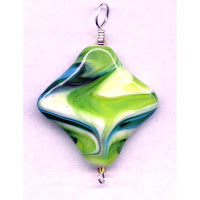
Thought I'd try and give a short overview of lampwork, and the lampworking process. Lampwork is, simply, melting and working glass over a flame.
Torches of various kinds are in general use to do this. I use the smallest, cheapest type of torch available. It's called a hothead.
There are many different types of glass that can be used, but the main two you will see are:
Soft glass (most of it manufactured in Italy) usually used to make glass beads. It has a low melting point, so you don't need a really big torch.
Hard glass (also known as Pyrex or borosilicate, or just plain boro), which can be used to make anything from pendants and beads to goblets and small bowls.
I make beads out of soft glass, so that is what I'll tell you about. To make a soft glass bead, the glass is generally melted and wrapped around a steel rod, or mandrel, that has been dipped in a claylike bead release to make the hole in the center. Each color of glass is individually applied as dots, lines, squiggles, frit (broken glass), or in the form of previously made elements such as twistie (glass that has been twisted together) or murrini (glass shapes). The tools can vary from scissors, ice tongs and dental picks, to those that are specifically made to work with glass. Almost anything goes as long as it is made of stainless steel, brass or graphite.
So that's it in a nutshell.
Now, what should you be looking for in a bead? Well, much of that is subjective, but there are a few general rules:
1) The beads should have nice finished ends- they should not be sharp as they can crack, chip or cut through the cord they are strung on.
2) They should have clean holes. After the beads are taken off the mandrel they are reamed to clean out all the bead release.
3) They should not be cracked. As glass has liquid qualities, even a small crack can grow over time.
4) There should not be unintentional tool marks or chill marks on the glass. Sometimes tool marks are used as a design tool. Chill marks are concentric circles which are left after a cool tool touches the glass. As a general rule, these marks should be fire polished out.
5) If there are decorative dots on the beads, they should not be undercut. They need to be firmly attached to the base bead so they can't break off.
6) The beads should be kiln annealed. Annealing is a slow cooling process that equalizes the temperature in the glass while it cools.
7) If you are looking at pictures on the internet, the photos should show the bead from all sides. My beads often have quite different looks, depending on how they are viewed.
There are other things to look for- are there unintentional bubbles in the glass? They do not cause any technical problems, but the more strict school of thought is that there should not be. After that, it's mostly a subjective thing. I could sit here all day telling you about the different techniques used, (and I plan on doing some of that later) but when it come right down to it, it all just depends on what strikes a chord with you. And do I follow all these rules? Well, I certainly try, though I admit there are sometimes a few chill marks I didn't notice when the beads come out of the kiln. Ok, that's about enough of that.
Hope this has been informative. And if you're a hot glass worker (or buyer), I hope you'll add your two cents.

1 comment:
thank you for the insight into what to look for in glass beads
Post a Comment